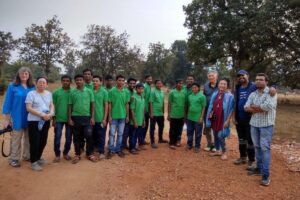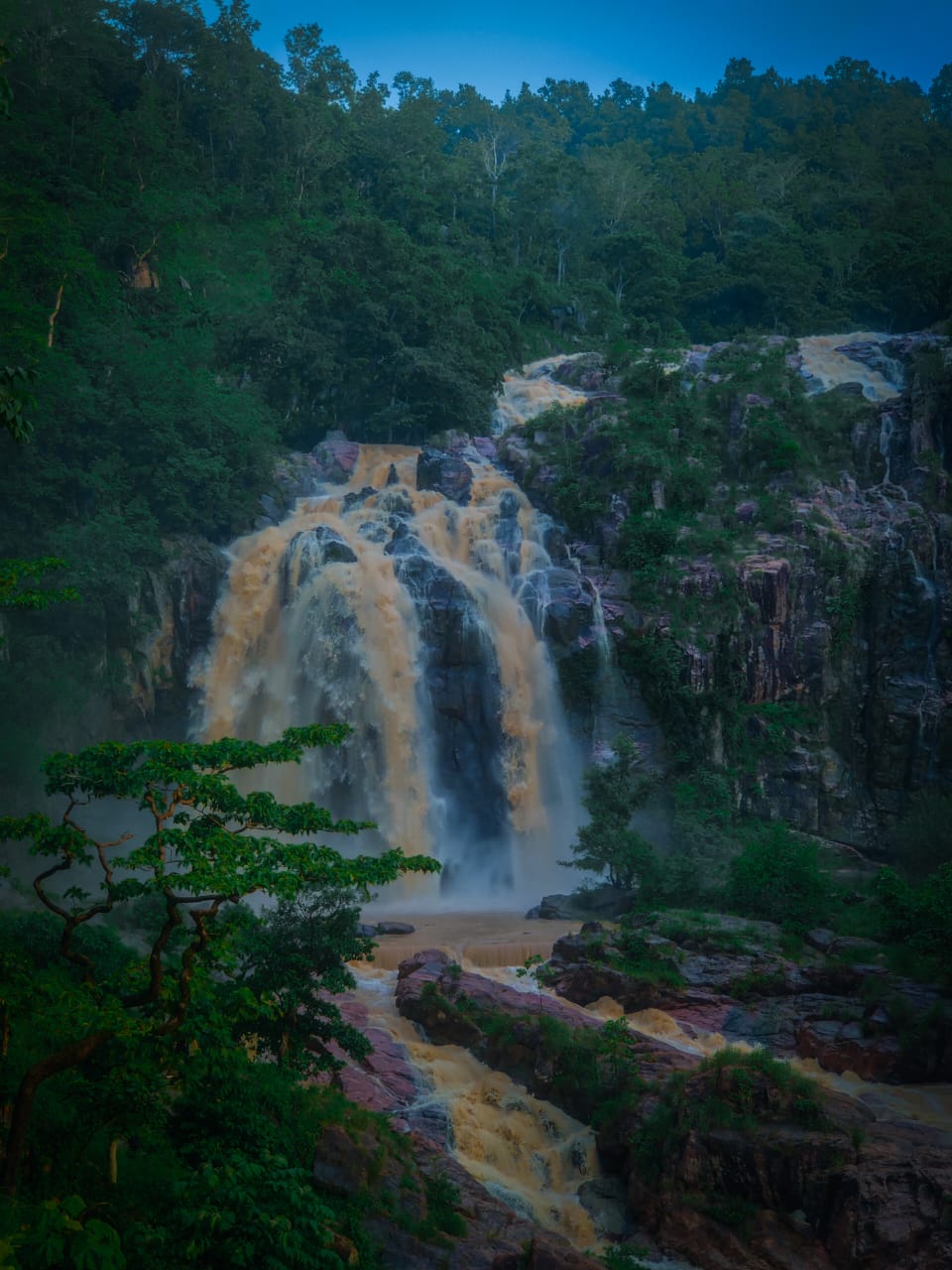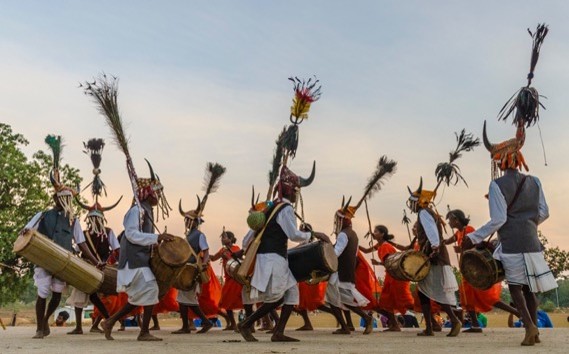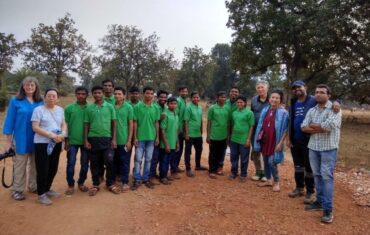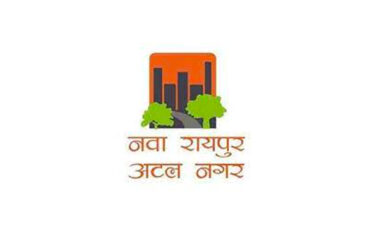DANTEWADA, DANTESHWARI AND DUSSEHRA
blog by B.Bindu
On the confluence of rivers Shankini and Dankini, Dantewada is a place of ancient, archaeological and historical importance. The Kuldevi (family goddess) of the earlier ruling dynasty of Bastar, Maa Danteshwari is the presiding deity of Dantewada. The world famous and the longest festival, Bastar Dussehra starts and ends by worshipping Danteshwari. Dantewada, Danteshwari and Dussehra are the symbols of– history of the past era– heritage of the future—truth of the present.
Around 10th century, Rajputs of the Ganga dynasty shifted their reign from Jagannathpuri to Barsoor village, near Dantewada. They made Barsoor their capital. In 11th century, the Naga dynasty rulers gained victory over the Ganga dynasty rulers. At that time, the Devi from the Devgudi of the nearest village Taarlapaal was being well-known. When the Naga dynasty ruler, Jagdeshbhushan heard about Matagudi, he shifted his capital along with his deity Devi Manikeshwari to Taarlapaal and renovated the Matagudi. Nearby he constructed a temple and established his Kuldevi Maa Manikeshwari. Due to Matagudi and temple construction, the glory of Taarlapaal increased. Villagers from far off places came to Mata for safety of their life, animals and prosperity. Taarlapaal thus became the centre of spirituality at that time.
In 14th century, Annamdev, the ruler of Kaktiya dynasty with his whole might gained victory over the Naga dynasty rulers and entered Chakrakot. After gaining victory in Bijapur, he overruled Barsoor also. After visiting Manikeshwari temple in Taarlapaal, he too made Taarlapaal his capital and established his Kuldevi Danteshwari in the same temple. From that time, this temple became famous as Danteshwari temple and village Taarlapaal’s name got converted to Dantewada which is presently, District Headquarters.
Situated in Dantewada, Devi Danteshwari is considered a form of Maa Durga and one among the 52 Shakti peethas. According to legends, Prajapati Daksha didnot invite Lord Shiva in yagya. Even then, Devi Sati went to her maternal home and attended it, where being humiliated, she committed self-immolation in the yagya pit. Being informed by his attendants, Lord Shiva became very angry. Virbhadra and Bhadrakali arose from his anger. They destroyed Daksha-Yagya. At that time, devatas worshipped to calm him. Looking at the corpse of Sati, Lord Shiva carried her on his shoulder and started dancing. Then, Lord Vishnu cut Maa Sati’s deceased body with his Sudarshan Chakra into 52 pieces. The spots where these pieces fell consecrated as Shakti Peethas, 52 in number. The episode of tooth-falling in southern parts of India has been recorded in Puranas. Narayani Devi Warahi Shakti Peetha is located in Shuchindram, Tamil Nadu. In the geographical part of Dandakaranya, Maa Danteshwari arosed in Bastar at the spot where the tooth fell and Danteshwari Shakti shrine got created in Dantewada.
According to another legend, Raja Annamdev was blessed by Maa Danteshwari that the distance he covers keeping his face upright would be under his territory. But the condition was, Raja Annamdev must not turn back or else Maa Danteshwari would stop at that place. As per the instructions, Raja Annamdev walked in front of Maa Danteshwari upto Rajim, the riverside of Pairi, where the sound of her anklets stopped due to sand . Raja turned back and Maa Danteshwari could not accompany him further but she blessed him to protect his 22 generations. She gifted him a fine cloth and told, the area under the cloth would confine the borders of his territory. It is possible that the state acquired its name ‘Bastar’ from this cloth. In this way, Maa Danteshwari got established from Warangal to Barsoor, then from Barsoor to Dantewada.
Now villagers from the nearby villages around Dantewada easily visit Maa Danteshwari and pay homage. But in ancient times, lack of modes of transport led villagers to create Matagudi in their respective villages and worship Maa Danteshwari in different forms. They consider them to be sisters of Maa Danteshwari and they are 32 in number, so, they are referred as ‘Batthis Behna’. Each Devi Maa has her own importance and place, different styles of paying homage. Among these 32 sisters, some of the important ones are: Danteshwari, Kotgudin, Pendrawadin, Kankalin, Pardesin, Mawali, Bijilikarin, Sitala, Jalnibudi, Dayamule, Gangadayi, Kesarpalin, Hingalajin, Dabagosin, Dulardeyi, Rewagdin, Hirmadai, Kolakaamini, Ganganadai, Paatakadai, Peeladai, Ghaasbedindai, Semariya etc. According to the traditions, they are worshipped in the forms of Maa Danteshwari. Since these Devis (goddesses) are at different Matagudis, they are worshipped according to the regional rituals. Otherwise they are the forms of Maa Danteshwari and Maa Mawali is the most prominent.
Nearby Danteshwari Mata Mandir at the confluence of Shankini-Dankini, legend relates to the remembrance of Shankini and Dankini in rituals. They are present in Lord Shiva’s group. Tourists visiting Dantewada as well as the pilgrims take a holy dip in the confluence of Shankini-Dankini and collect its water to eliminate the possession of ghosts. Persons possessed with ghosts are rescued by sprinkling the water of Shankini-Dankini.
Dantewada district contains Sathdhar waterfalls, Bhadrakali confluence spot, Baila Dila iron ores, Sakalnarayan caves, Tulaar caves, Milkulwada-Handawada waterfalls, mesmerizing valleys of Jhiriya, Phulpaad waterfalls etc. as amazing tourist places. Apart from Dantewada, Maa Danteshwari temple is also constructed in the RajMahal premises at Jagdalpur. During Dussehra and several festivals, chatra of Maa Danteshwari is brought from Dantewada to Jagdalpur. The statue of Maa Danteshwari at Dantewada is magnificient and while observing its top part very carefully, one can see another form. One of the forms of NavDurga can be recognized on Maa Danteshwari’s forehead in sayanmudra. In Jagdalpur, the magnificient white marble statue of Maa Danteshwari is constructed by Utkal Vishwakarmas. The temple situated in RajMahal premises, being the presiding deity of Rajparivar portrays the fine art in floor, roof and walls. Dussehra starts on Hariyaali Amavasya, when the trunk of a tree named ‘Turlu Khotla’ is brought to Maa Danteshwari’s temple. This trunk is completely used in the construction of Dussehra Rathas ( chariots) in the form of wooden hammer and wooden nails. Bastar Dussehra starts from the day of ‘Hariyaali Amavasya’ and continues till 75 days. This festival ends with the departure of chatras of various devi-devatas and Maawali Mata from Maawali Shivir at Gangamunda.
Bastar Dussehra is the festival of cultural rituals, celebrated for the longest period in the whole world, meeting place of numerous devi-devata, coronation of Raja Purushottam Dev in the 15th century and continuation of rituals since 600 years without any discord. These features have made it unique in itself.
History about the Dussehra festival celebrated from ancient age says, Raja Purushottam Dev Maharaja offered emeralds to Jagannathpuri and got the title of Rathapati. After being coronated in 1408 and coming back from Puri, Raja Purushottam Dev ordered construction of a chariot of 16 wheels, then gave 4 wheels for the construction of Lord Jagannath’s chariot and constructed a chariot from the wheels left. The second chariot is constructed with 4 wheels. Once 7 chariots were used to move during Dussehra, among which one chariot was of Lord Jagannath. Now 3 chariots take the procession. These rituals add uniqueness to Bastar Dussehra.
After bringing the trunk of ‘Turlu Khotla’ at Danteshwari temple, next amazing ritual is—‘Kaachangudi’ : means ‘swing of thorns’ or providing throne to ‘Kaachan Devi’. On the day of Ashvin Amavasya at Kaachan Devi temple located on Patharaguda road, a young girl is swinged on thorns by a priest to satisfy the goddess. Then the girl gives permission to carry on Dussehra without any chaos. After that at Jagdalpur, in GolBazaar premises, “Raila Devi” is paid homage.
On Ashwin Shukla Prathama ‘Navaratra Dussehra’ festival starts with prayers offered by Brahmins, Kalash Sthaapana, Chandi Paat, prayers offered to Hanuman and Baglamukhi Devi, Lord Vishnu along with various gods and goddesses, which lasts whole Navaratra period. On the same day, at ‘Sirasaar’ Sirhasaar, ‘Jogi Bithai’ ritual is carried out. It is the installation of a man from Halba tribe who sits on a vigil for nine days and nights to watch over the festivities. There is a ritual of ‘cutting seven Mangur Maach’ during Jogi installation while a goat was sacrificed earlier.
The chariot procession (Rath Parichalan) starts on Ashwin Dwithiya. From dwithiya to saptami, the four-wheeled chariot completes its procession starting from Mawali Mata and Jagannath temple to Sirasaar. This chariot decorated with flowers is called ‘Phool Rath’. On saptami, it is the last procession of ‘Phool Rath’. On ashtami, the procession of ‘Nisha Jatra’ reaches to ‘Pooja Mandap’ of Sunday Market (Ithwari Bazaar). On navami, at ‘Sirasaar’ all the rituals of Jogi Uthaani is carried out and during evening, the Doli of Maa Danteshwari from Dantewada is welcomed in the form of ‘Maawali Mata’, ritual known as ‘Maawali Parghav’. On the occasion of Dussehra, Maa Danteshwari comes to Jagdalpur in the form of Maawali Mata. Priest along with the people of Rajparivar receive the Doli of Maawali Mata on their shoulders and carry it to ‘Maa Danteshwari Mandir’.
On the day of Vijayadashmi, “Bhitar Raini” and on Ekadasi, “Baahar Raini” is celebrated. Large number of people gather to celebrate Dussehra on these two days and the spectacular eight-wheeled chariot’s procession is carried out. On the day of Vijayadashmi or ‘Bhitar Raini’, ‘Raja’ used to ascend this rath in warrior-outfit. Now-a-days, the chatra of Devi Maa is ascended to rath. On Vijayadashmi, after Rath Parikrama, the people from Bhathra tribe stole it and bring it to kumhadakot. On ‘Bahar Raini’ or Ekadeshi, the rath is brought back.
On Ashwin Dwadashi, people express their happiness for the completion of ‘Dussehra Festival’ without any discord and offer prayers in Kaachan Devi temple. On the same day, Muriya Darbaar is organized in Sirasaar Bhawan. In ancient times, it was the public meeting place between the king and the masses. The last stage, on the day of Trayodashi, ‘Kutumb Jatra’ or ‘Ganga Munda Jatra’ takes place. On this day, Devi-Devatas of various villages and Maa Maawali are respectfully set-off to their places. The phenomenal Bastar Dussehra ends on this day.
To Join Bastar Dussehra Tour :- https://www.unexploredbastar.com/trip/bastar-dusshera-tour/


